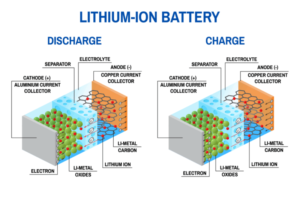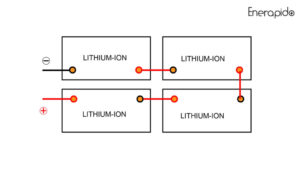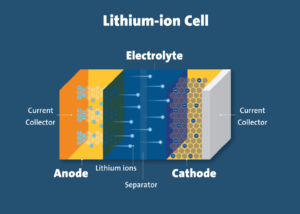LIFEPO4 vs Lithium ion vs LTO
Regarding the energy density of LIFEPO4 vs Lithium-ion cell, With the maturity and upgrading of rechargeable lithium ion battery technology, which is 3-4 times higher than that of lead-acid batteries. Lithium batteries have been used in electric vehicles maturely and stably, and they are very popular. The 500-1000 kilometers of battery life has made consumers no longer worry about the process and anxiety. The fast charging technology or battery swapping technology of various electric vehicle brands is also one of the main reasons why more and more consumers are choosing electric vehicles.
In fact, lithium batteries include various types of rechargeable batteries, such as NCA, NCM, LTO, LIFEPO4, etc., and model – cylindrical, poly, prismatic cell, which are all LTO, Lithium-ion, lifepo4 cell types, that belong to lithium ion batteries.
The positive electrode material of nickel cobalt lithium manganate/nickel cobalt aluminate (NCA&NCM) is a mixture of nickel (Ni), cobalt (Co), manganese (Mn), or aluminum (Al) in proportion. lifepo4 batteries refers to the positive electrode material of the battery as lithium iron phosphate. Different materials lead to great differences in the performance of NCA NCM Lithium ion and lithium iron phosphate batteries.
lithium ion battery pack ( NCA/NCM cell ) have the advantage of the highest energy density and are the earliest lithium battery technology used in electric vehicles. However, safety issues, it is also the reason why their installed share in the electric vehicle market is rapidly decreasing.
With continuous innovation in lithium iron phosphate materials, processes, and assemble Technology, the performance of lithium iron phosphate is steadily improving, and its cost, life, and safety advantages are also relatively significant.
Especially with the continuous maturity of the R&D technology of power battery companies, the CTP technology of the CATL era, and the blade battery technology of BYD, CATL has launched the third-generation CTP technology – “Kirin battery” through continuous technological iterations, and its system weight, energy density, and Volumetric energy density continue to lead the industry at the highest level. Under the same chemical system and the same battery pack size, the power of the Kirin battery pack can be increased by 13% compared to Tesla’s latest technology 4680 system.
The discharge voltage platform of lithium-ion NCA/NCM cells is 3.7V, the discharge voltage platform of lithium iron phosphate cells is 3.2V, and the discharge voltage platform of lithium titanate cells is 2.3V. High energy density is the biggest advantage of ternary lithium batteries. , and the voltage platform is an important indicator of the energy density of the battery, which determines the basic performance and cost of the battery. The higher the voltage platform, the greater the specific capacity. Therefore, the battery with the same volume, weight, and even the same ampere-hour has a higher voltage platform. The lithium battery of the element material lasts longer or releases the most energy in the same volume and weight.
Advantages & Disadvantages of NCA NCM Lithium ion vs Lifepo4 vs LTO
Safety -LIFEPO4 vs Lithium ion vs LTO
NCA NCM lithium-ion cell:
three elements of nickel, cobalt, and manganese are used. Nickel and cobalt are active metals, and the chemical reaction is very active. When the battery temperature is 200°C, oxygen molecules will be released, which will aggravate the combustion of electrolyte materials. The electrolyte will vaporize and destroy the battery casing under the action of high temperature. After meeting with the air, it will burn, and even more seriously will cause an explosion.
LFP battery:
Benefit from the properties of the battery material itself. When the temperature of the cell reaches a high temperature of 500-600 °C, the chemical composition of the positive and negative materials inside it begins to decompose. Because the P-O bond in the lithium iron phosphate battery crystal is stable, it will not form strong oxidizing substances even at high temperatures. Under the limited oxygen supply of the battery compartment, it cannot generate high temperature instantaneously by itself, and it is difficult to meet the conditions of explosion. The lithium iron phosphate battery itself has good safety.
Lithium titanate battery / LTO cell:
The potential of lithium titanate is higher than that of pure metal lithium batteries, it is not easy to generate lithium dendrites, the discharge voltage is stable, and, therefore, the safety performance of lithium batteries is improved.
The lithium titanate battery will not emit smoke, fire, or explode under severe tests such as acupuncture, extrusion, and short circuit, and its safety is much higher than other lithium batteries.
Low-temperature performance - LIFEPO4 vs Lithium-ion vs LTO
LTO cell:
The spinel structure of lithium titanate battery has three-dimensional lithium ion diffusion channels, so the performance of lithium titanate battery in high and low-temperature performance is also very good. It can be charged and discharged normally at -50°C to 60°C, and the lithium titanate battery has good wide temperature resistance and strong durability.
NCA/NCM li-ion vs lifepo4 cell:
The three-dimensional structure of the cathode material restricts the diffusion rate of lifepo4 cells, and the impact is very obvious at low temperatures. The discharge performance of lifepo4 cell and lithium-ion rechargeable battery cell at -20 ℃, the discharge capacity of lithium iron phosphate batteries at -20 ℃ can only reach 67.38% of the normal temperature capacity, while the NCA/NCM batteries can reach 70.1%.
In the ultra-low temperature environment, the viscosity of the lithium battery electrolyte in the rechargeable battery increases, which improves the characteristic impedance of the lithium-ion battery.
Lithium iron phosphate battery charging electrode material, the conductivity is relatively weak, easy to cause polarization state, reduces lithium capacitance. The polarity of lithium iron phosphate PO4 is too strong, the binding ability to Li is large, and the diffusion coefficient is low. The NCA/CNM material does not have this problem, so at low temperatures, the charge and discharge are less affected.
Cost-effective - LIFEPO4 vs Lithium ion vs LTO
A year ago, compared with NCA/NCM lithium-ion batteries, the cost of lithium iron phosphate batteries had obvious advantages. However, in the past year, due to the outbreak of the new energy industry, the positive and negative materials of NCA/NCM and lifepo4 have skyrocketed by about 10 times. However, the unit price of the cell is still less than 1/3 of that of the lithium titanate cell.
The disadvantage of LTO’s cost and capacity density kills all the advantages of lithium titanate batteries: extremely high safety, low-temperature resistance, super fast charge performance, and ultra-high discharge rate performance.
Cycle Life
Among the mainstream lithium battery manufacturers, the performance test data are as follows (data test conditions @80%DOD @25℃ @1C discharge & Charge): Lithium ion NCA / NCM cell cycle life 1000-2000+ times, LIFEPO4 cell: 3000 ~ 6000+ cycles (prismatic cell), LTO cell: 30000+ cycles.
Please note that the cycle life of any rechargeable battery will be affected by changes in environmental factors (cycle depth, high and low temperature, and rate are the main factors – the high temperature has the most obvious effect).
In the daily use of lithium batteries, through good maintenance and maintenance, the service life can be further extended.
Energy Density:
According to the latest information released by CATL, its ternary lithium-ion battery products have a cell mass-energy density of 300Wh/kg, and its lithium iron battery have a cell mass-energy density of 200Wh/kg.
Among the lithium-ion battery brand manufacturers, the density of the batteries that have been mass-produced, the energy density of LIFEPO4 cells is about 150wh/kg, and the energy density of NCA NCM cells is about 200wh/kg.
The energy density of lithium titanate batteries is about 61-91wh/kg, which is still 1.5-2 times higher than that of lead-acid batteries; although the energy density of iron-lithium batteries is about 25% lower than that of NCA NCM batteries, compared to that of lead-acid batteries. The energy density of lead-acid batteries and lithium titanate batteries has been 2-3 times higher. Fully meet the requests of the civil and commercial consumption market.
Discharge & Charge Rate
The significant advantage of lithium-ion batteries is the charge and discharge rate, the standard rate is 1C ( charge and discharge rate = charge and discharge current / rated capacity)
The power rate of NCA/NCM and LIFEPO4 lithium battery is divided into standard power type (1C-3C) and ultra-high rate power type (3C ~ 30C continuous discharge rate). The instantaneous discharge rate can reach Max 50C, which fully meets the requirements of power equipment. Parameter requirements for startup and high-speed motor operation.
Lithium titanate battery (LTO), the continuous and instantaneous charge and discharge rates of yinlong’s cylindrical &prismatic cells 30Ah 40ah are 10C & 20C;
Fast Charge and Discharge
Li-ion battery rate advantage Quick charge and discharge, with standard NCA/CNM & LIFEPO4 1C rate cells: max continuous charging rate – 0.5C – 1C charging rate, that is, 1-2 hours to complete charging, lead-acid batteries need more than 10 It takes hours to charge, a huge convenience.
With a continuous discharge rate of 1C, it can quickly charge and discharge to meet the fast charging needs of energy storage and Powersport devices. Fast charge and discharge is the biggest advantage of lithium titanate batteries.
Smart Technology Solutions
Lithium-ion batteries are undoubtedly the best choice for functions that require intelligent communication and data monitoring & management of the type of equipment. With the commercial application of lithium-ion batteries, the supporting BMS system technology has also been improved and developed synchronously, which can meet the needs of various intelligent applications of lithium batteries, and its precision and intelligence are unmatched by lead-acid batteries.
Volume and Weight
The energy density of NCA/NCM lithium battery is 3-4 times that of lead-acid battery, and its volume and weight are greatly reduced, which is more convenient for users to carriage and application. It enables the rapid application of lithium batteries in various application fields, such as home energy storage, RVs, Marine, Electric Vehicle Industry and other industries. In contrast, the lower energy density of lithium titanate batteries is one of the important reasons for the failure of large-scale commercial applications.





